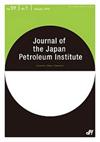Treatment of Oily Waste Using a Scaled-up Carbonization Kiln
IF 0.6
4区 工程技术
Q4 ENERGY & FUELS
引用次数: 0
Abstract
Treatment of oily wastes generated in production and refining processes is one of the major environmental issues facing the petroleum industry in oil producing countries. Oily wastes such as crude oil storage tank sludge and oil-based drilling mud contain various hazardous materials such as oil (petroleum hydrocarbons) and heavy metals. Generation of oily waste is increasing, and combined with the processing cost and capacity limitations of currently available treatment technologies, is resulting in the accumulation of large amounts of untreated oily waste1). Consequently, inexpensive and effective treatment methods are now needed. Various technologies have been investigated for the treatment of oily wastes. Solvent extraction2),3) has high oil removal efficiency, and allows oil recovery, but the cost is very high and so is considered to be impractical. Biological treatment methods4)~7) capable of large-scale treatment such as land farming can be implemented at low cost, but the treatment period is lengthy and the space requirement is large. Additionally, some oily wastes such as crude oil storage tank sludge contain resin and asphaltene that is difficult to treat biologically. Thermal decomposition treatment8),9) such as carbonization has high oil removal capability and also allows oil recovery, so development continues as a promising technology. For example, addition of various catalysts improves the oil recovery amount and recovered oil quality, resulting in decreased overall treatment cost10)~14). However, the properties of oily wastes can vary greatly by location and over time1),15), so thermal decomposition treatment using a catalyst must adapt the optimum conditions, such as catalyst type and addition amount, to the properties of the oily waste to be treated. This study investigated carbonization treatment (pyrolysis) using superheated steam, without any catalyst, to remove oil from waste. Superheated steam is generated under the operating pressure (steam at 100 °C under normal pressure) and further heated to a temperature higher than the boiling point. This superheated steam heats anoxically, as heat is directly applied without air. Air heating acts only by convection, whereas superheated steam has very high heat energy that can be transferred by condensation and radiation, as well as convection, resulting in superior heat efficiency compared to air heating. In an earlier study16), carbonization treatment using superheated steam removed oil concentrations in waste [Regular Paper]用放大炭化窑处理含油废物
石油生产和精炼过程中产生的含油废物的处理是石油生产国石油工业面临的主要环境问题之一。含油废物,如原油储罐污泥和油基钻井泥浆,含有各种有害物质,如石油(石油碳氢化合物)和重金属。含油废物的产生正在增加,加上目前可用的处理技术的处理成本和能力限制,导致大量未经处理的含油废物的积累1)。因此,现在需要廉价和有效的治疗方法。人们研究了各种处理含油废物的技术。溶剂萃取法(2)、3)除油效率高,而且可以回收油,但成本很高,被认为是不切实际的。能够进行土地耕作等大规模处理的生物处理方法(4)~7)可以低成本实施,但处理周期长,占用空间大。此外,一些含油废物,如原油储罐污泥,含有树脂和沥青质,难以生物处理。热分解处理,如碳化,除油能力强,而且还能回收石油,因此作为一项有前途的技术继续发展。例如,添加各种催化剂可提高采收率和采出油的质量,从而降低总体处理成本10)~14)。然而,含油废物的性质会因地点和时间的不同而有很大差异1),15),因此使用催化剂的热分解处理必须根据待处理含油废物的性质调整最佳条件,如催化剂类型和添加量。本研究研究了在不使用任何催化剂的情况下,使用过热蒸汽进行炭化处理(热解)以去除废物中的油。在工作压力下(常压下100℃的蒸汽)产生过热蒸汽,并进一步加热到高于沸点的温度。这种过热的蒸汽在没有空气的情况下直接加热,是无氧的。空气加热仅通过对流起作用,而过热蒸汽具有非常高的热能,可以通过冷凝和辐射以及对流传递,因此与空气加热相比,热效率更高。在早期的一项研究中,使用过热蒸汽的炭化处理除去了废物中的油浓度。
本文章由计算机程序翻译,如有差异,请以英文原文为准。
求助全文
约1分钟内获得全文
求助全文
来源期刊

Journal of The Japan Petroleum Institute
工程技术-工程:石油
CiteScore
1.70
自引率
10.00%
发文量
29
审稿时长
>12 weeks
期刊介绍:
“Journal of the Japan Petroleum Institute”publishes articles on petroleum exploration, petroleum
refining, petrochemicals and relevant subjects (such as natural gas, coal and so on). Papers published in this journal are
also put out as the electronic journal editions on the web.
Topics may range from fundamentals to applications. The latter may deal with a variety of subjects, such as: case studies in the development of oil fields, design and operational data of industrial processes, performances of commercial products and others
 求助内容:
求助内容: 应助结果提醒方式:
应助结果提醒方式:


